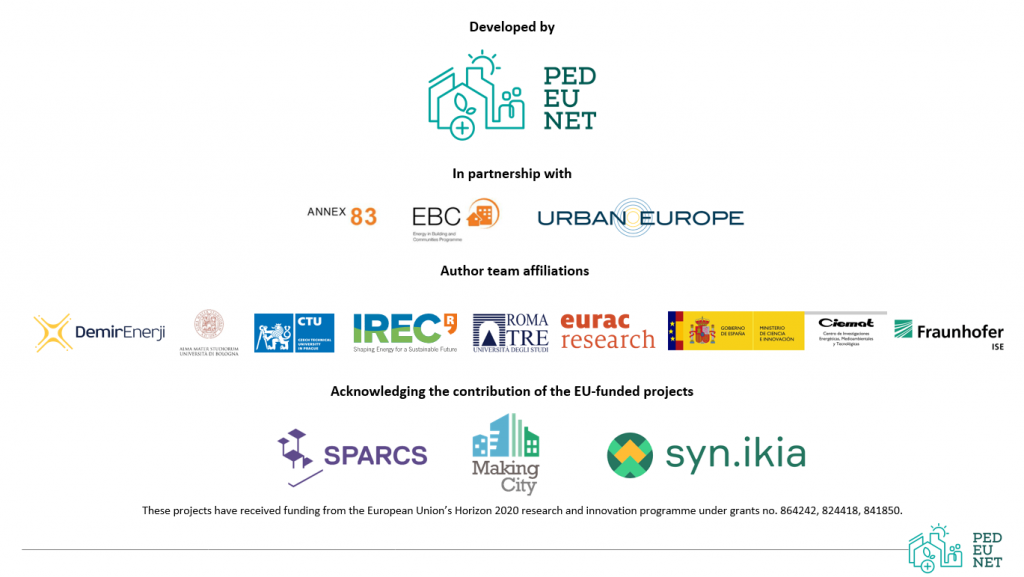| D1P001: Name of the project | |
| D1P001: Name of the project | InterPED - INTERoperable cloud-based solution for cross-vector planning and management of Positive Energy Districts |
| D1P002: Project assigned code | |
| D1P002: Project assigned code | Grant Agreement number 101138047 |
| D1P003: Start date | |
| D1P003: Start date | 01/24 |
| D1P004: End date | |
| D1P004: End date | 12/26 |
| D1P005: Ongoing project | |
| D1P005: Ongoing project | Yes |
| D1P006: Funding programme/financing model | |
| FP7/H2020/HEU/DUT | yes |
| FP7/H2020/HEU | HEU |
| Interreg | no |
| National funding | no |
| Public-Private Partnership - please specify | no |
| Other | no |
| D1P007: Estimated project costs (Mill. €) | |
| D1P007: Estimated project costs (Mill. €) | 3.3 |
| D1P008: Description of project objectives/concepts | |
| D1P008: Description of project objectives/concepts | InterPED will develop the technical and business ecosystem to demonstrate the potential of positive energy districts (PEDs), by integrating the local RES and excess/waste heat (E/WH) sources with the local energy systems, to bring economic benefits, improve grid stability and robustness, contribute to the energy system decarbonisation, and reduce carbon footprint. This will be achieved by meeting the following general objectives , setting the conditions for wide-scale replicability across districts around Europe: ● Integrate existing and emerging ICT tools to deploy InterPED cloud-based solution enabling integrated, reliable and decarbonized PEDs based on sector coupling, high demand flexibility services, citizen participation, while increasing RES hosting capacity to above 50% share in overall energy supply. ● Validate the InterPED solution in 4 large-scale pilots in different technical, market and climate contexts, while demonstrating improved grid robustness owing to the cross-vector integration and optimal asset management (RES, storage, E/WH sources, EVs), while unlocking at least 30% of demand flexibility. ● Develop partner-backed viable plans for the post-project replication of the InterPED solution to 4 “follower” districts, which measure positive impact on wider energy infrastructure, environment, local economy and social aspects owing to sector coupling, increased share of RES and improved grid operation. |
| D1P009: Description of project upscaling strategies/potential | |
| D1P009: Description of project upscaling strategies/potential | InterPED aims to create a platform suitable for efficient scaling up and replication to other districts, with four "follower" districts already joining the project for post-project replication. Once the project is completed, local energy communities and service providers will be fully trained to take full ownership of the solution and its business ecosystem. |
| D1P010: Number of PED case studies in the project | |
| D1P010: Number of PED case studies in the project | 4 |
| D1P011: Case Study | |
| D1P011: Case Study | |
| D1P012: Description of project expected impact | |
| D1P012: Description of project expected impact | |
| D1P013: Standardization efforts | |
| D1P013: Standardization efforts | InterPED will support standardization efforts related to data handling and data management issues (CEN-CLC-ETSI M/490), and align with EC’s Smart Grid Task Force (SGTF) and IEC TC57/WG21 on the smart grid interoperability, e.g. in the context of OpenADR 2.0 and USEF. As part of these efforts, InterPED is also involved in the BRIDGE initiative and has applied for the HSBooster programme. |
| D1P014: Sources | |
| D1P014: Sources | |
| D1P015: Can you specify a suitable contact person regarding the load-management approach within your PED project? | |
| Name | Lorena Sanchez |
| lorena.sanchez@r2msolution.com | |
| D1P016: Would you be willing to share data from your PED project for research purposes? | |
| D1P016: Would you be willing to share data from your PED project for research purposes? | Yes |

Authors (framework concept)
Beril Alpagut (Demir Energy); Giulia Turci (University of Bologna); Michal Kuzmic (Czech Technical University in Prague); Paolo Civiero (Università Roma Tre); Serena Pagliulia (University of Bologna); Oscar Seco (CIEMAT); Silvia Soutullo (CIEMAT); Daniele Vettorato (EURAC Research, IEA Annex 83); Bailador Ferreras M. Almudena (CIEMAT); Vicky Albert-Seifried (FHG ISE)
Contributors (to the content)
Laura Aelenei (LNEG), Nienke Maas (TNO), Savis Gohari (OsloMet), Andras Reith (ABUD), Ghazal Etminan (AIT), Maria-Beatrice Andreucci (Universita Sapienza), Francesco Reda (VTT, IEA Annex 83), Mari Hukkalainen (VTT), Judith-Borsboom (Locality), Gilda Massa (ENEA), Jelena Ziemele (University of Latvia), Nikola Pokorny (CVUT), Sergio Diaz de Garayo Balsategui (CENER, IEA Annex 83), Matthias Haase (ZHAW, IEA Annex 83), Christoph Gollner (FFG, JPI UE), Silvia Bossi (ENEA, JPI UE), Christian Winzer (Zurich University of Applied Science), George Martinopoulos (Centre for Research and Technology Hellas), Maria Nuria Sánchez (CIEMAT), Angelina Tomova (Energy Agency of Plovdiv), Oya Tabanoglu (Demir Enerji), Jelena Brajković (University of Belgrade), Juveria Shah (Dalarna University), Michela Pirro (ENEA), Francesca Sabatini (University of Bologna)
Implemented by
Boutik.pt: Filipe Martins, Jamal Khan
Marek Suchánek (Czech Technical University in Prague)